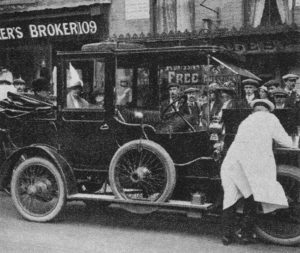
Motor On: Churchill Thwarted (Or: For Once, the Authorities Prevailed)
The distinguished historian Paul Addison sends along a minor but amusing tale of a Churchill motor car (probably his new Napier). Churchill didn’t get his way, because he himself wasn’t behind the wheel. Had he been driving, he would likely have proceeded to get round the obstruction by driving on the pavement (sidewalk). This perilous endeavor was witnessed firsthand later on by WSC’s bodyguard, Detective-Inspector Walter Thompson.
Turned Back: The Home Secretary and his Motor
Daily Herald, 10 April 1911— Mr. Winston Churchill had a curious experience on Saturday while motoring to Banstead. Part of Sutton High Street is under repair, and two barriers are erected. The first barrier does not completely bar the way.
Mr. Churchill’s car was able to proceed past the first barrier before having to stop. As the car stopped, Adams, the foreman in charge of the work, stepped out and told the chauffeur he would have to turn back as the road was stopped.
Mr. Churchill sent the chauffeur to ask permission of the constable on the beat for the passenger of the car, and the barrier was at once lowered. The foreman, however, placed himself in front of the car and said they would have to go over his body first.
“Don’t you know who it is?” whispered the officer.
“I don’t care who it is,” retorted the foreman.
Mr. Churchill, gently remonstrating, said, “Don’t get cross,” to which Adams responded, “You’re not going through here, whoever you are. Those are my instructions.”
After a few words with the constable, the car was turned round and proceeded on its journey through the side streets.
Pressing on Regardless
Churchill stopped driving himself in the late 1920s, after numerous hair-raising motor adventures between London and his country home Chartwell. When WSC decided to drive personally, his bodyguard Walter Thompson worried: “It either means that he is cross and subconsciously wants to smash up something, or that he is dangerously elated and things will get smashed up anyhow through careless exuberance.”
This didn’t make him any less a menace on the road, since he constantly urged his drivers to exceed speed limits and overtake frequently. Two anecdotes from Part 2 of my article, “Blood, Sweat and Gears”….
Once, doing 80 on a curve, a rear tyre blew and “a van full of irate constables screeched to a halt alongside. They had been trying to catch the runaway for miles.” Realizing who it was, they helped fix the tyre. “Churchill stood off to one side, serenely puffing at a cigar. He made no sign of apology but only got in and cried, ‘Drive off!’ The constables saluted humbly.”
On a campaign trip to Wales, Churchill conversed garrulously with O’Brien, his PR officer. They passed the brandy back and forth. Churchill urged such reckless speed that Clementine Churchill cried: “Please let me out. I refuse to continue this ride.” With the utmost courtesy, Churchill stopped at a country railway station and escorted her to the platform. Then, plying the brandy bottle, he ordered the driver “down the road like a bat out of hell for Cardiff.”
By the time they arrived, what with the brandy and his nerves, O’Brien was “done up—out practically cold. Churchill supervised the laying out of his PRO on a table in the rear of the hall. Then he went ahead and made a rouser of a speech. Afterward, he appeared confused about the origin of O’Brien’s trouble, and expressed the opinion that it was ‘probably something he ate.’”






